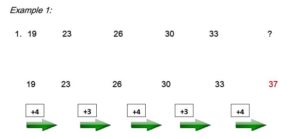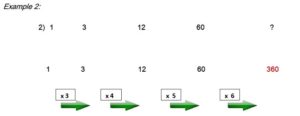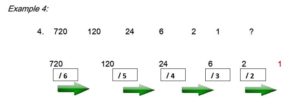Number Series Shortcuts and Mind Tricks: Dear Readers, Aptitude Shortcut methods and tricks for Number Series Questions were given below.
Quantitative Aptitude is one of the most important sections of any bank exam. In addition, a very scoring topic of the banking syllabus under the Quantitative Aptitude section is Number Series. The arrangement of numbers in a certain order, and in which some numbers are placed wrongly in the series and some numbers are missing is called a number series. Applying these Number Series Shortcuts provided below with examples will make you attempt the questions easily with good accuracy. Practice more questions in the number series PDF by applying these tricks and shortcuts provided here. Revise these Number Series Shortcuts and Mind Tricks regularly and apply them while solving the Number series questions for bank exams to score better on this topic.
Important Points to Remember:
i). If numbers are in ascending order in the number series.
Numbers may be added or multiplied by certain numbers from the first number.
SET – I:
Step 1: Check whether it is ascending, descending, or mixed order.
Step 2: It is in ascending order. So add or multiply by certain numbers from the first number.
Step 3 : The difference between first number and second, and the difference between second and third and so on., are in increasing order of +4 and +3
Step 4: Hence the answer for the above series is 37.
Step 1: Check whether it is ascending, descending, or mixed order.
Step 2: It is in ascending order. So add or multiply by certain numbers from the first number.
Step 3: By adding the first number and second, and second and third and so on., it is not in the sequence of increasing order. Try multiplication
Step 4: Take 1 and 3, let’s start multiplying 1*3=3, by seeing this we get to know, by multiplying 3*4 it gives 12, and 12*5=60.
Step 4: Hence the answer for the above series is 360.
ii). If numbers are in descending order in the number series,
Numbers may be subtracted or divided by certain numbers from the first number.
SET – II :
Step 1: Find whether the given number is in descending order.
Step 2: It is in descending order. So subtract or divide by certain numbers from the first number.
Step 3: The difference between the first number and second, and the difference between second and third and so on, are in order of -16,-8,-4,-2
Step 4: Hence the answer for the above series is 3.
Step 1: Check whether it is ascending, descending, or mixed order.
Step 2: It is in descending order. So subtract or divide by certain numbers from the first number.
Step 3: By dividing the first number by 6 it gives 120.
Divide 120/ 5 =24, 24/4=6, 6/3=2, 2/2=1 .It is in decreasing order.
Step 4: Hence the answer for the above series is 1.
iii). If numbers are in mixing order (increasing and decreasing) in the number series.
Numbers may be in addition, subtraction, multiplication, and division in alternate numbers.
Step 1: Check whether it is ascending, descending, or mixed order.
Step 2: It is in mixing order. So it may be in addition, subtraction, division and multiplication, squares and cubes.
Step 3: In the above series, it is mixing of the square, addition, and subtraction.
(14)2= 196+4= 200
(13)2=169. By adding 4 it gives 173. Try subtraction.
169-4=165
Here we found it is in order of squaring a number, adding by 4, and subtracting by 4.
Step 4: Hence the answer for the above series is 77.
Step 1: Check whether it is ascending, descending, or mixed order.
Step 2: It is in ascending order. So add or multiply by certain numbers from the first number.
Step 3: In the above series, let’s add the first number with 3 i.e.,14+3= 17
But with the second number, we can’t able to add +3 and so on.
Let’s try adding the first number and second number i.e. 14+17=31
Second and third, i.e. 17+31 =48 and so on
This series is in the form of miscellaneous
Step 4: Hence the answer for the above series is 79







